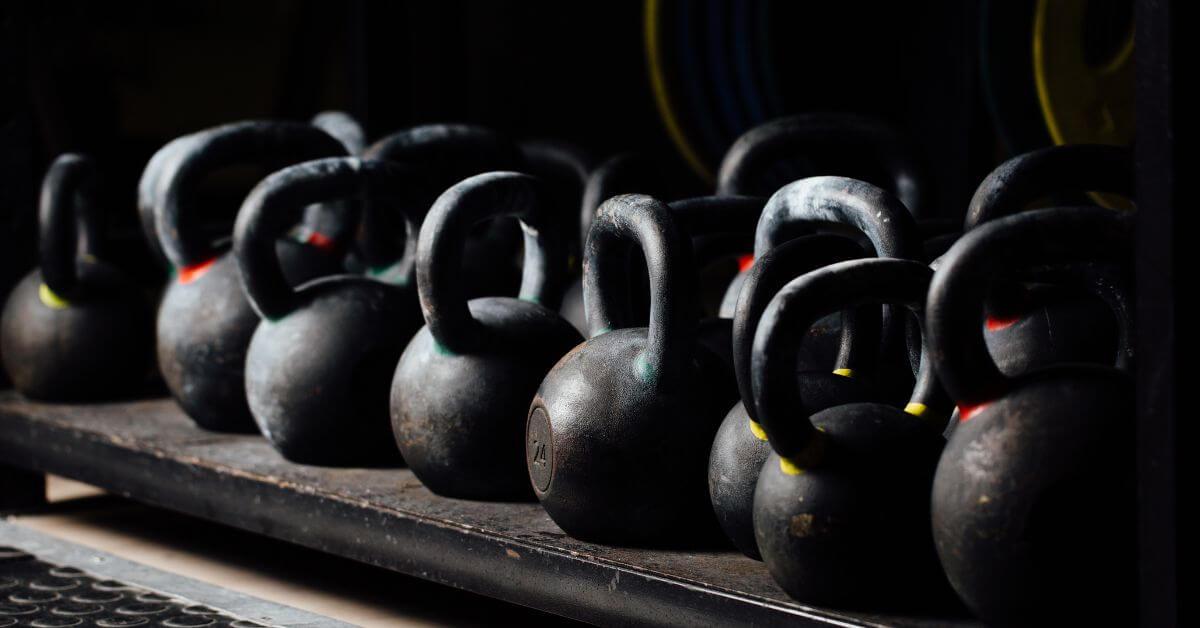The kettlebell is one of the best training tools for toning, building muscle, and even burning fat. By their very nature, common kettlebell workouts strengthen the grip and build strength and endurance, especially in the lower back, legs, and shoulders.
Table of Contents
ToggleThe fundamental exercises, like the swing, snatch, and clean and jerk, involve the entire body simultaneously and are designed to replicate everyday tasks like cleaning. They are also lightweight, affordable, and simple to store, which is an advantage. This is a simple guide to maximizing each kettlebell exercise.
Start Building Your Dream Body Today
Ready to elevate your fitness game without falling into the trap of dull, repetitive routines that just don’t deliver? Imagine sculpting your ideal physique and boosting your health, all while still enjoying life’s pleasures, like those irresistible weekend getaways and your aunt’s legendary cheesecake. With our online fitness and nutrition coaching service, you don’t have to compromise. Dive into a personalized fitness journey that blends perfectly with your lifestyle, not against it. Book your completely free discovery consultation today, and take the first step towards a transformation that doesn’t require giving up the joys of life.

“I was skeptical about online fitness coaching, but Functional Body Savage completely changed my perspective. Vanja and Radomir’s personalized approach and attention to detail have helped me achieve goals I never thought possible. I’m stronger, more confident, and grateful for their guidance.”
Emily Thompson, San Francisco, CA
Learn More About Our Online Coaching ServiceQuick Summary
- Kettlebells are used to increase explosiveness, balance, and core strength. Activities range from endurance drills that build muscle mass and strength across various muscle groups to grip-strengthening workouts.
- The kettlebell deadlift is one of the most popular kettlebell exercises.
- You should carry a kettlebell weight that will enable you to perform the exercise you are beginning with five times when choosing your weight (reps).
- Overall strength, core strength, balance, flexibility, and coordination can all be improved using kettlebells.
What Is a Kettlebell?
Kettlebell is a cast iron weight with a handle for an easy grasp that ranges from 5 lbs to over 100 lbs. It is called a “kettlebell” in English; it resembles a cannonball with a handle or a teapot without a spout.
The Russian-made kettlebell first gained popularity in the United States decades ago, but thanks to a rush of classes, films, and books, it has had a comeback in recent years.
The cause?
With dynamic exercises that target nearly every facet of fitness—endurance, strength, balance, agility, and cardiac endurance—kettlebells offer a unique way to train. Because it is difficult, effective, and only requires one piece of equipment to work an entire body, people adore it.
Kettlebell Usage: What Are Kettlebells Used For?
Kettlebells are used for improving core strength, balance, and explosiveness. Exercises range from grip-strengthening drills to endurance exercises that increase muscle mass and strength in different muscle groups.
Unlike exercises using dumbbells or barbells, kettlebell workouts entail a lot of repetitions both during competition and during everyday training. Kettlebell exercises can be performed continuously for several minutes or with brief rests because they are holistic, working multiple muscles simultaneously.
Because of this, the workout is only partially anaerobic and more equivalent to high-intensity interval training than to conventional weightlifting. While performing exercises with many repetitions, kettlebell progression should start slowly to build muscle endurance, support the joints, and avoid injury.
When performed incorrectly and without good teaching and progression, exercises using any functional training equipment can be risky for people with back, shoulder, or weak core issues. A Kettlebell workout can help with enhanced strength, flexibility, range of motion, agility, and cardiovascular endurance.
The Anatomy of a Kettlebell
Kettlebells come in various shapes, designs, and colors but have similar basic anatomy.
Here are all parts of a kettlebell:
- Handle: The handle’s upper section is typically utilized to control movement.
- Corners: The curving part of the handle on either side where it begins to bend down toward the bell
- Horns: The two spots where the bell and each side of the handle connect.
- Window: The space between the bell and handle. Windows can have varying sizes according to the kettlebell design and manufacturer.
- Bell: The kettlebell’s center of mass. Typically, the bell is round.
- Base: That part of the bell’s flat bottom that is used to support its upright position.
Many training methods, including bottoms-up kettlebell training, are possible when the handle, corners, horns, and bell are used to their full potential.
What Muscles Do Kettlebells Work?
Kettlebells work muscles like the glutes, hamstrings, quadriceps, erectors, trapezius, rhomboids, deltoids, and abdominals. Regular kettlebell training will make your upper arms, shoulders, and legs feel notably tighter and stronger.
When fat is lost, you will become more defined and improve your posture. You will have an overall air of healthy athleticism and appear balanced, muscular, and graceful.
How to Use Kettlebells?
To use kettlebells, you should start slowly and become acquainted with the grip and balance before moving on to a higher weight range for your kettlebells. The weight shifts the center of gravity in front of the body during workouts, putting beginners in danger of injury.
The weight should be distributed evenly between the heels for most kettlebell exercises. By doing so, balance is maintained, and the back is shielded from harm. When carrying a heavy object, all movement should start from the legs rather than the back.
The kettlebell swing is among the most common kettlebell exercises.
Innumerable kettlebell exercises target different body areas and achieve diverse strength objectives. The secret to any workout is to start slowly, employ excellent technique, and gradually increase the weight to prevent damage.
5 Best Kettlebell Exercises for Beginners
Picking something up off the floor, sitting down and standing back up, carrying groceries in, and a long list of other actions are just a few examples of how functional movements learned in kettlebell training may be applied in daily life.
You may increase your strength and stability, lower your chance of injury, and benefit from the crossover effects in everyday life by learning how to perform these fundamental movements effectively and appropriately. This is where working with a certified kettlebell instructor may come in handy.
Anyone learning how to use a kettlebell will benefit significantly from the following five functional exercises.
1. The Kettlebell Deadlift
The deadlift is a hip-hinge exercise that develops your glutes, hamstrings, and core muscles while laying the groundwork for the kettlebell swings you’ll see next. There are also a ton of kettlebell deadlift variations you may use.
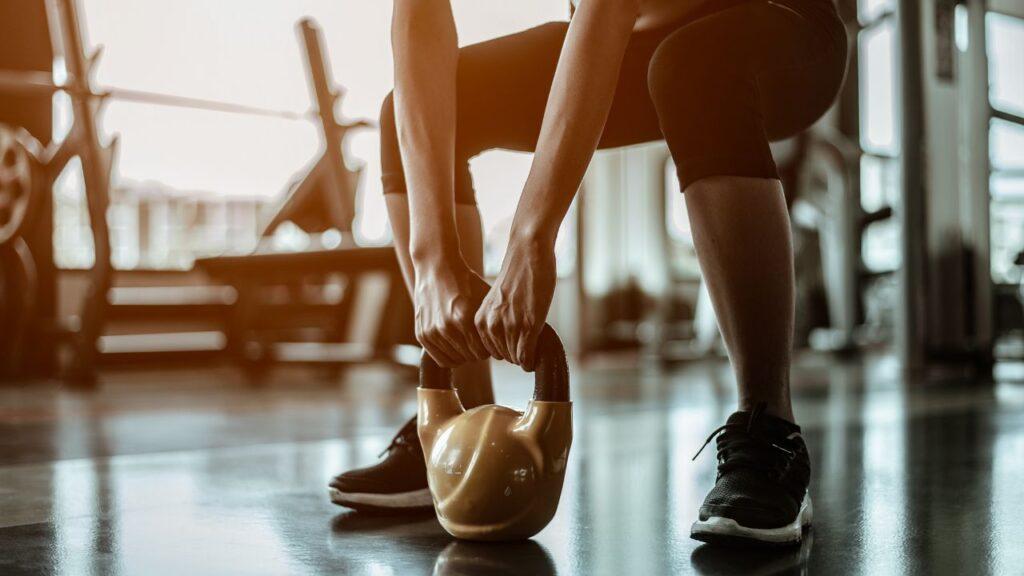
How to Perform a Kettlebell Deadlift
- Stand with your toes pointed slightly out and your feet slightly wider than shoulder-width apart. In line with the front of your ankles, the kettlebell should be placed directly in the middle of your feet.
- Set your hips back.
- Maintain a straight back, elbows out in front of your hands, and eyes on the horizon as you reach for the kettlebell.
- Seize the handle firmly.
- Envision contracting your glutes and extending your legs as you push your feet into the ground. As you exhale, hiss slightly.
- You should stand tall at the top of the deadlift, your abs, quadriceps, and glutes clenched. Maintain a relaxed, shoulder-width distance from your ears.
- To put the bell back on the ground, hinge at the hips.
2. The Kettlebell Swing
The kettlebell swing is the cornerstone of kettlebell training. It can raise your strength and cardiovascular endurance while enhancing your sports performance. The kettlebell swings are ballistic exercises meant to be performed quickly, so keep that in mind.

How to Perform a Kettlebell Swing
- Standing position with your toes pointed slightly outward and your feet slightly wider than shoulder-width apart. A foot or so should separate you from the kettlebell.
- Reach out and tilt the kettlebell handle toward you while keeping your spine neutral and your hips hinged back. Maintain your focus on the horizon.
- Using a loose grip, wrap your fingers around the handle. Hike the kettlebell back between your legs while taking a breath.
- The kettlebell should swing back and forth between your knees like a pendulum until your forearms hit your inner thighs if your shoulders and hips are motionless.
- Snap your hips, stand straight, and tense your glutes, quadriceps, and core to begin the forward swing. The bell should only rise to chest height with the help of momentum. When the bell rises, hiss out your breath, closing your lips only when it reaches chest height.
- Keep your shoulders tight as the bell naturally descends, and before you bend your hips back to begin another rep, wait until you feel your arms coming down on you.
3. The Goblet Squat
The goblet squat is an excellent lower-body and kettlebell exercise for building strong glutes, strengthening your quadriceps and calves, enhancing mobility, and increasing flexibility.
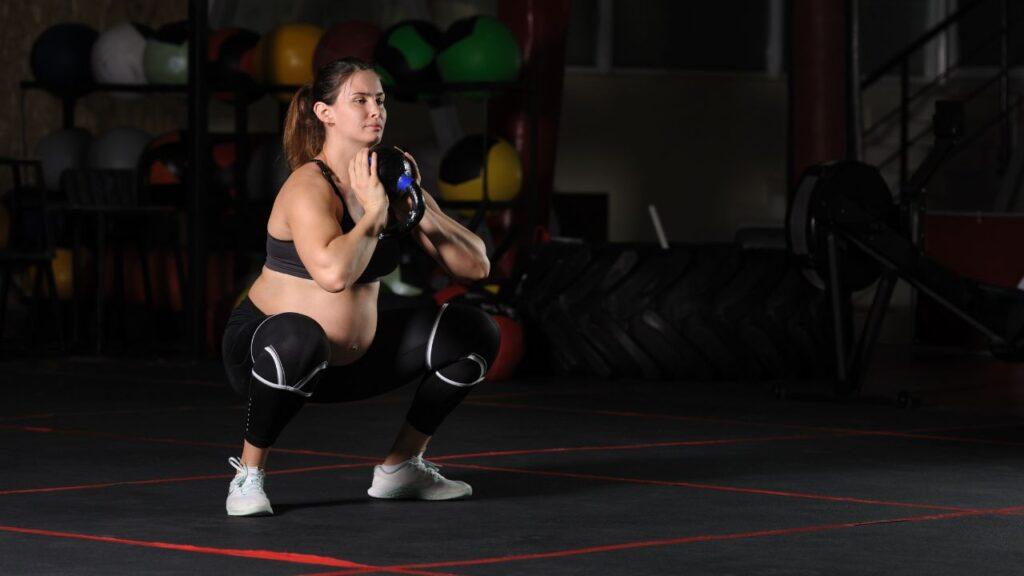
How to Perform a Kettlebell Goblet Squat
- Place your feet shoulder-width apart as you stand. Keep the kettlebell’s horns near your chest when holding it.
- Send your hips back and bend your knees so that you are preparing to sit on a curb to squat. Your knees should track over your toes, and your hips and knees should flex equally.
- Maintain a neutral spine and a raised chest.
- Do so as low as you can squat without bending your back or pelvis tilting under.
- Imagine forcing your feet through the ground as firmly as you can while you stand by pressing through your heels. While you breathe out, gently grunt to contract your pelvic floor muscles actively.
- It should feel like the top of your head is pulling up a string as you stand straight to full hip extension.
4. The Farmer’s Carry
Farmers carry is an excellent kettlebell exercise. This movement is a powerful one that works every muscle in your body. Carries can help you:
- Improve stability and balance.
- Get practical strength for daily tasks.
- Boost overall endurance.
- Increase your grip power.
With kettlebells, you may perform a number of weighted carries, such as one-arm, overhead, racked, and suitcase carries, but for now, let’s start with the most fundamental one: the farmer’s carry.
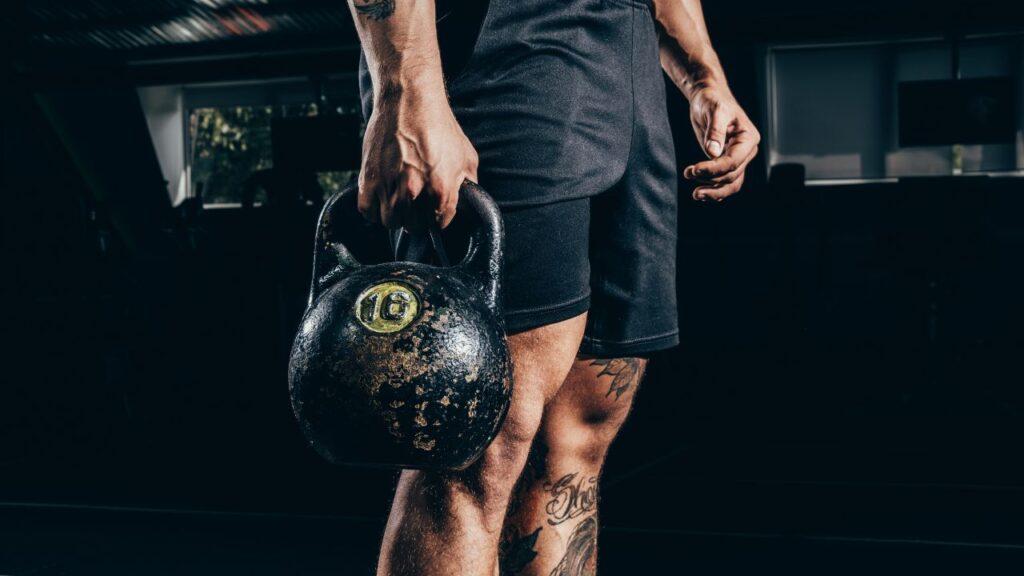
How to Perform a Farmer’s Carry With Kettlebells
- Your feet should be hip-width apart as you stand between two kettlebells. The handles of the bells should be parallel to your legs and situated just outside your ankles.
- Using your deadlift motion, hinge back, grip the handles, and stand back up.
- Consider how your posture is aligned: Your ribs should be above your hips when you stand tall with tight abs.
- Walk slowly to shift your weight from heel to toe with each step. Keep your shoulders down and away from your ears, and avoid letting your arms and hands hang by your sides.
5. The Turkish Get-up
Keep things easy, enjoyable, and relaxed when wearing the Turkish get-up (TGU). While performing this kettlebell workout, remember to pause every so often and assess your breathing, distance, and eye posture. The TGU is a full-body exercise that will test your overall resilience, shoulder mobility, stability, and core strength.
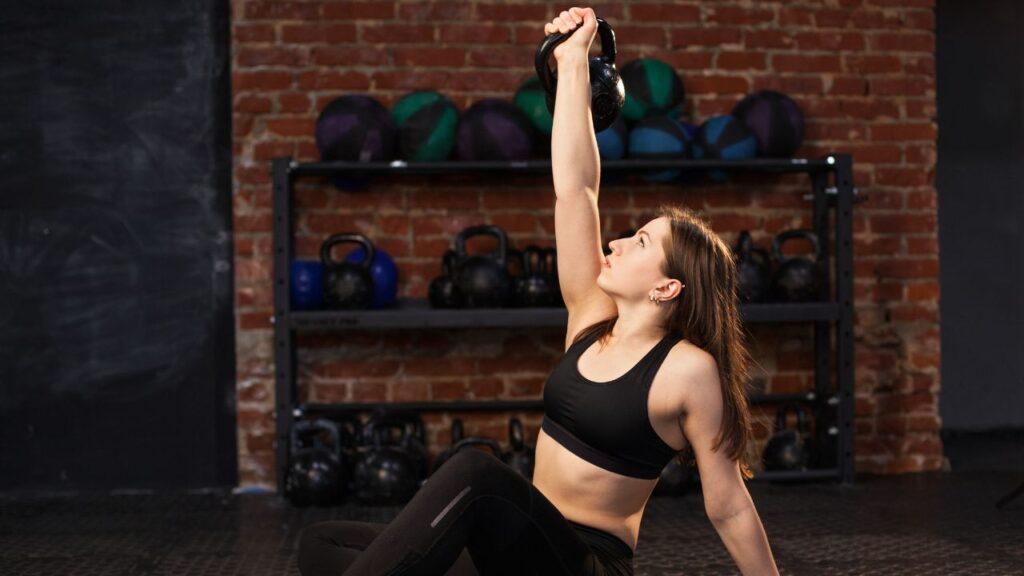
How to Perform a Turkish Get-up With a Kettlebell
- Kettlebells should be placed close to you as you begin by resting on your right side in a fetal posture. Grab the handle by extending your right hand through the kettlebell window.
- Lift the kettlebell to your forearms in a vertical position as you roll onto your back while keeping the elbow of the laden arm on the floor.
- Your right foot should be flat, and your right knee should be bent. At a 45-degree angle to your torso, your left arm and leg should be stretched and pressed into the ground.
- Press the kettlebell with a neutral wrist until your right arm is fully extended and your wrist, elbow, and shoulder are in line. Keep a pack on your shoulder.
- Pressing with your right foot and rising onto the opposite hip and elbow while maintaining focus on the kettlebell. Bring your left leg behind you with a low sweep, knee bent to the floor, and eyes fixed on the kettlebell.
- Get your torso into a lunge stance by pushing your hand into the floor, locking your weighted arm vertically, and packing your shoulders. From the lunge, raise yourself to a standing position while looking straight ahead.
- Return your eyes to the kettlebell as soon as your hand reaches the ground again, and hold it until you are back in the starting position.
- Do the same on the other side.
4 Tips for Training Safely With Kettlebells
There are four crucial safety recommendations for novices to remember during their kettlebell workouts.
1. Always Be Aware of Your Surroundings
Choose a non-slip training place where you aren’t afraid to drop a kettlebell while choosing a location for your workout. Don’t leave your equipment out; ensure the area is clear around you.
2. Select Footwear Wisely
In a kettlebell workout, it’s critical to be able to plant your feet firmly on the ground. You should ideally train barefoot or in shoes with wide, flat soles, so your toes have room to spread out.
3. Practice Proper Form
Treat every kettlebell as though it weighs 100 pounds. While lifting it up and putting it down, use proper form! We don’t want any accidents to happen here.
4. Don’t Force It
The kettlebell is capable of acting independently. Avoid attempting to force the rep if it is falling. Just direct the kettlebell to land as softly as you can, and if necessary, get out of the path fast.
How to Choose Your Kettlebell Weight?
To choose your kettlebell weight, you should carry a kettlebell weight that will allow you to complete whatever exercise you are starting with 5 times (reps). It can be difficult to decide which size kettlebell to start with when you’re just starting.
A lighter weight (8–16 kg) will be good for exercises like kettlebell overhead presses or Turkish get-ups, while a medium–to–heavy weight (12–20 kg) may be more effective for squats and deadlifts. Using two different weights will allow you to perform a greater number of exercises and variants.
You must first test the bell to ensure that you don’t overestimate or underestimate your strength before choosing a reasonable weight for different kettlebell workouts. Instead of starting with a higher weight and working your way up, start at the lower end of the spectrum.
And keep in mind that picking a kettlebell will rely on various elements, including your age, strength, degree of fitness, and personal objectives. Pay attention to your body’s signals regarding what weight will challenge you without risking your safety.
FAQs
What Do Kettlebells Do for Your Body?
Kettlebells do help you improve overall strength, core power, balance, flexibility, and coordination. Using kettlebells, you can build strong, lean muscles while melting fat.
Are Kettlebells Better Than Dumbbells?
Yes, kettlebells are better than dumbbells. The biggest benefit of kettlebells is that they help you gain strength and power in your back, shoulders, and lower body muscles.
Do Kettlebell Exercises Really Work?
Yes, kettlebells do really work. You might combine strength training with an aerobic exercise session, depending on the program.
Is It Ok to Do Kettlebells Everyday?
Yes, it is okay to do kettlebells every day. Kettlebell swing is one exercise you could do daily, but it will depend on the intensity of your workouts, your level of experience, and how quickly you recover from the session.
Can Kettlebells Transform Your Body?
Yes, kettlebells can transform your body. Your body will have lean muscle tissue due to kettlebell exercises, giving you a firmer, leaner, and more toned appearance.
What Are the Best Kettlebells to Start With?
The best kettlebell to start with to build muscle, burn fat, and maintain fitness is 26 lbs, with a progressive increase to 44 lbs. The optimum kettlebell sizes for ordinary active women to tone up, burn fat, and stay in shape are 18 lbs for beginners, with a gradual build-up to 26 lbs as you grow used to the bells.
Kettlebell training is a fantastic alternative to weight lifting to burn fat and tone your body. You want a weight that you can use for HIIT exercises and with little downtime if your objective is to burn fat.
This means you should use less weight than you would for workouts involving typical sets, repetitions, and more extended rest periods.
Start Building Your Dream Body Today
Ready to elevate your fitness game without falling into the trap of dull, repetitive routines that just don’t deliver? Imagine sculpting your ideal physique and boosting your health, all while still enjoying life’s pleasures, like those irresistible weekend getaways and your aunt’s legendary cheesecake. With our online fitness and nutrition coaching service, you don’t have to compromise. Dive into a personalized fitness journey that blends perfectly with your lifestyle, not against it. Book your completely free discovery consultation today, and take the first step towards a transformation that doesn’t require giving up the joys of life.

“I was skeptical about online fitness coaching, but Functional Body Savage completely changed my perspective. Vanja and Radomir’s personalized approach and attention to detail have helped me achieve goals I never thought possible. I’m stronger, more confident, and grateful for their guidance.”
Emily Thompson, San Francisco, CA
Learn More About Our Online Coaching Service
